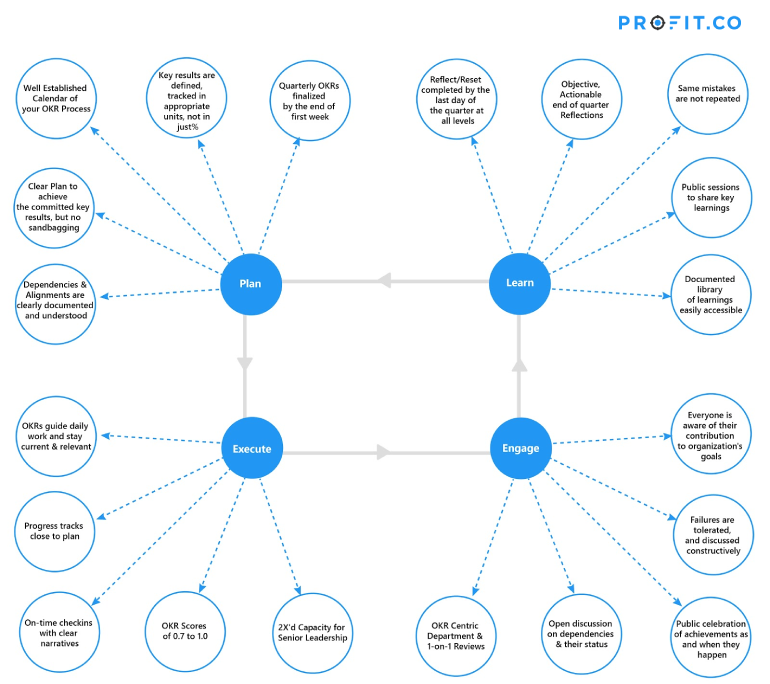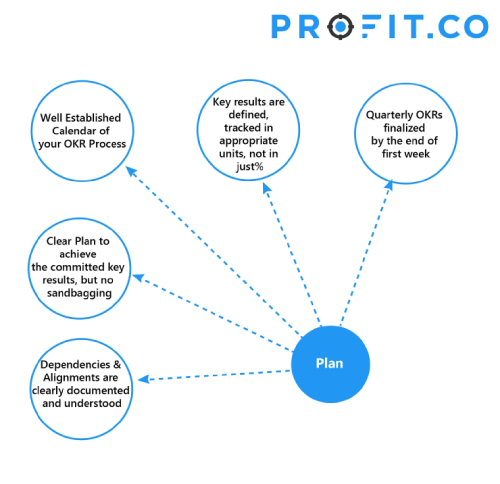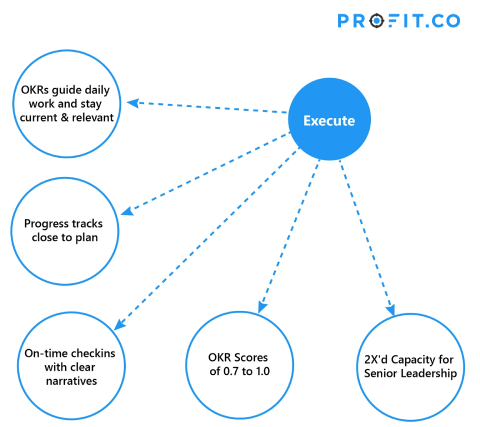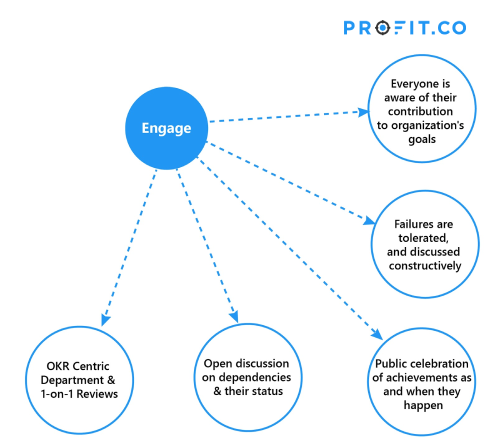Based on your organization’s unique DNA, you can prepare yourself to plan how to get started with OKRs, the important thing is to get started. Profit.co’s OKR software has been developed to help businesses move through the OKR cycle using the PEEL approach (Plan, Execute, Engage and Learn), which are the 4 clear areas in every good OKR implementation. Let’s take a look at each step of the PEEL cycle, and the corresponding signs that let you know you’re doing something right.

These four areas are interestingly ordered by the perceived level of importance in most OKR programs. Most companies pay a lot of attention to planning, slightly lesser attention to execution, and even less to engaging and pretty much ignore learning. As you encounter problems in this journey, you have to address the issues in these four areas properly. Otherwise, you could end up with a failed implementation in your hand. Watch out for the 20 red flags in these four areas that need your utmost attention.
Just as there are visible signs when something is weak, there are signs when something is a success. When it comes to OKR methodology, there are ways to tell when you’re doing something right. These are just as important to identify, because when you can identify them, you can replicate them, building on your understanding and expertise.

P: Plan
The first step in the PEEL cycle is Plan. It’s important to know what you’re doing correctly early in your OKR program progress, because when you have a strong foundation, it’s easier to bring that strength into your next steps.
Quarterly OKRs finalized by the end of the first week
When you’re first beginning with OKRs, finalizing your quarterly OKRs by the end of your first week can seem like a daunting task. You might not yet have a clear sense of what you’d like to achieve for the entire quarter.
However, when you plan your OKRs in your second quarter, you’ve learned a little more– and in your third quarter, this process might go even more smoothly. By your fourth quarter with OKRs you might have a rhythm with which you can plan clear OKRs at all levels: from company-wide to individual.
It’s important to finalize your quarterly OKRs within the first week of your quarter. If you’re doing this with your OKR implementation, that means there doesn’t have to be a lot of tension or discussion surrounding your goals. Everyone is on the same page, and there is probably very little wandering around or blaming one another for a lack of clarity or loose understanding of dependencies and alignments.
If you have your OKRs defined by the end of the first week of the quarter, this is one sign that your OKR program has matured and is running smoothly.
Key Results are Defined and Tracked in Appropriate Units- not just percentages
The second sign of a successful program is that your key results are clearly defined and tracked using the appropriate units– not just measured in terms of the percentage completed.
Generally, when people first start out creating key results, they have a tendency to use the percentage tracked key result type. Then, after some time, you gain the confidence and understanding to graduate to more concrete, tangible units of tracking.
For example, instead of having a key result to “Improve customer satisfaction score by 30 or 40%” you’d create a key result to “Increase customer satisfaction score from 80 to 95”. This is a more specific, useful way to define your key results, and indicates maturity in your understanding and creation of OKRs.
Well-established Calendar of your OKR Process
Having a well-established calendar indicating your OKR process is an important sign that you’re doing something right. Having a clear idea of your quarter and being able to visualize how frequently you’d like to hold certain meetings is incredibly important to being successful with OKRs.
Being able to designate things like Monday OKR status meetings, or weekly progress plans, or Friday check-in processes and frequent touch-bases to check on your progress and that of your dependents is a good indicator that you’re well on your way to having a well-established calendar.
Some events and meetings might be held once a month, or once a quarter. For example, you could designate that every first or third Wednesday, you and your team are going to celebrate goal-setting successes, or do brown bag question sessions. Monthly meetings can and should be at an increasingly local level, getting down to the departmental and team levels.
Once a quarter you might have a company “town hall” meeting in a larger setting where you talk about achievements, failures, lessons learned, and even rewards or recognitions at the division level or business unit level.
Clear Plan to Achieve the Committed Key Results– without sandbagging
With OKRs, you should be encouraging yourself and others to stretch. Because some of the goals you are setting might be “stretch goals,” you could fall into a pattern of dreaming big without actionable steps to achieve that dream. To achieve, you need a plan a business is not run solely on stretch goals.
You’ll want to have a clear level of achievement understood prior to beginning, and a clear plan for delivering that. However, you need to strike a balance between achievable and aspirational to maintain clarity and possibility without promoting sandbagging– or, setting your goals low so you can most certainly achieve them.
Dependencies and Alignments are Clearly Documented and Understood
Dependencies and Alignments are an important part of your planning process, because you need to understand how your highest, corporate-level OKRs might flow down to the next level, your departments, and then to teams and individuals. The connections need to be clearly understood by everyone involved. If this is happening, then it’s a very good sign that you’re on track in your planning process.
This includes dependencies between teams. If one team needs to deliver X, they need to recognize that they need other teams to deliver Y and Z in order to fulfill their Objective. Clearly documenting and understanding dependencies and alignments is the last sign that you’re doing something right in your planning process.

E: Execute
When you have a steady foundation that has been built through the planning process, you’re ready to continue to the next stage of the PEEL cycle, which is executing your OKRs. Having a clear idea of what indicates you’re taking this step that right way can be helpful for you to find success during this stage. What are the signs you’re doing something right?
OKRs Guide Daily Work and Stay Current & Relevant
OKRs aren’t just important to the big picture; they should guide everyday work. If OKRs are staying current and relevant with what’s happening in your company day-to-day, then that’s a great sign that your OKR program is mature and your OKRs are being executed properly.
Sometimes, OKRs will be formulated at the beginning of the quarter, but by week four or five, the key results must change, as they lose relevance and importance. At times, a company does experience a shift in priorities in the middle of a quarter– but when this happens, your work tracking should reflect that. It should never be the case that work that is irrelevant to your OKRs is being completed.
Progress Tracks Close to Plan
Another symptom of success in this stage of the OKR progress that is similar to the last but is worth pointing out on it’s own is how closely your progress is tracking to expectations. There are situations where a certain key result could get a stunted start– such as no progress for the first six weeks.
You could reason that you might get to it later in the quarter– but this introduces an unneeded sense of anxiousness surrounding this goal. It’s better to see your key results progressing on schedule– especially if this is not an individual KR, but rather a team or departmental KR, or a KR with dependencies.
On-time Check-Ins with Clear Narratives
The next signal that the “execution” portion of your PEEL process is going well is that your check-ins are consistent, and paint a very clear narrative. This is perhaps the most important signal that your OKRs can give– this is the element that lets you know what was completed, and what got left out. It’s the very baseline of your key result progress, asking the big question: What did we get done?
Once you see this, you can figure out if there are any gaps, and determine a game plan for making up work and getting your team and your goal back on track.
OKR Scores of 0.7 to 1.0
OKR scoring at the end of the quarter will indicate how well you did with this aspect of the execution process. At the end of the quarter, you should be seeing an OKR score between 0.7 to 1.0. In some cases, you might dip below that, however if you’re seeing this score at the end of the quarter, it’s a good sign that you are succeeding in this stage of the PEEL cycle.
Doubled Capacity for Senior Leadership
An interesting symptom of success that you could see in this stage of the OKR process is an increased capacity for senior management. This extra time and room in the work lives of senior management would leave them room to focus on even bigger, bolder ideas to implement with the company.
Now, this symptom is subtle– it’s not a flashy, obvious sign that you’ll see all of the time. However, when it occurs, it’s a great sign that you’re doing something right with your OKR program. When seniors management doesn’t have to spend their time chasing down employees and following up with people in an attempt to organize all the tasks being executed in the company, they have more time to focus on bigger-picture items.
When this happens, a weekly review is sufficient to cover a lot of ground and updates with the team. Then, senior managers don’t have to chase down status updates. This will take time and effort, however it’s a prominent sign that your OKR program is progressing successfully.

E: Engage
An important element of the OKR process is engagement. Not just with OKRs themselves– even if everyone is doing their check-ins, there should be a larger, more unified engagement with OKRs through monthly meetings. When executed correctly, OKRs will integrate pretty seamlessly into your day-to-day work life. Let’s take a look at some signs that the engagement stage of the PEEL cycle is going right.
OKR-Centric Department and One-on-One Reviews
The standard pillar of employee engagement is reviews these can be at varying points throughout the quarter. Some managers might want to have weekly, biweekly, or monthly meetings to get up to date and put everyone on the same page.
Additionally, having one-on-ones with your direct employees is an important element of engagement. OKRs should be a big part of your daily, weekly, and monthly reviews. If they are, this is a great way to tell that the engagement stage of the PEEL cycle is going well, and your OKR program is matured and healthy.
Open Discussion on Dependencies & their Status
From an engagement standpoint, open discussion about dependencies and their status should be a large part of daily or weekly conversations. Chances are, your OKRs have both dependencies and alignments– these require communication. You can’t assume those that you have a dependency on will deliver, just as they should double-check that you will deliver. Everyone has to check-in with one another and keep updated.
If you and those you’re connected to are all participating in the check-on process and are having open conversations, and the progress being made is clear to all, that’s a great sign that your OKR program is running smoothly and efficiently.
Public Celebration of Achievements as, and when, They Happen
While any of these indicators can be deemed important, this particular one is very significant in that recognition is a large part of employee engagement. Both successes and failures have to be recognized.
You don’t want your environment to be a complaining environment; so celebrating achievements as they come– small, large, noteworthy or everyday is vitally important. If you’re doing this in your OKR program, you can maintain a very positive and improvement-oriented culture.
Failures are Tolerated, and Discussed Constructively
This symptom is important to discuss, because this might not feel like a symptom of success at all. How could failure be an indicator of doing something right?
This isn’t so much about the failure itself as it is about the reaction to failure. When people try something new, there’s not always going to be leaps and bounds of progress in terms of moving the needle. However, learning is a part of doing the work. The effort that goes into failure is effort that needed to be expended in order to come out better on the other side.
If you have a healthy culture surrounding failures– one that tolerates them, and finds solutions is a constructive, discussion-based manager, it’s a sign that your OKR program is going well.
Everyone is aware of their contribution to the organization’s goals
This particular symptom of success is important to know about because of what it indicates. The goals of an organization come from a very high level. Any team member or individual in the company, no matter how far down the chain of command they are, should be able to see how they are an important, impactful contributor to the organization’s OKRs. Alignments should be linked clearly to show who is contributing how.
This isn’t necessarily a visual component it’s more of a mental understanding. People knowing how they fit into the hierarchy or make impacts through discussions with managers and senior leadership as a part of regular meetings or larger town halls is a part of this symptom. If an employee can reason to themselves how their completion of task X fits into company goal Y, then your OKR program is running smoothly and successfully.

L: Learning
Learning is a very valuable part of the PEEL cycle. Arguably, it is what makes this process worth it; the fact that you’ll be able to learn lessons from the cycle that you can take along with you next time.
Documented Library of Learnings, Easily Accessible
A documented library of all the lessons you’ve learned through the OKR process as well as the well as your end-of-quarter reflections is a symptom of success that you should be very glad to have.
Not only is this useful for current employees, but it can act as an orientation booklet for new hires, who can now gain a clear understanding of their new role by looking at the OKR history– instead of them having to go through failures to learn lessons, those lessons will be documented, and they can build on the prior knowledge of the company so that they don’t repeat the same mistakes.
Public Sessions to Share Key Learnings
In the context of a calendar year, you should have at least monthly meetings where people can openly share key things that they learned and what mistakes they made with others in the company.
By sharing mistakes, and how you overcome those mistakes, there can be a communal sense of understanding and learning, and others can use the suggestions and warnings of others to move forward in their own goals and make progress.
Same mistakes are not repeated
How a person reacts to and tolerates failures says a lot about them. Being about to learn from those failures says even more. Companies that are doing well with their OKR programs will not have a lot of repeated failures amid their employees. If employees can share what goes wrong with one another and how to deal with that failure, then everyone will be better off.
No repeated mistakes indicates good communication in that company, and an open environment to talk and help one another. Keeping a catalogue of lessons learned is a way that one employee can share with an entire company and help everyone learn and improve.
Objective, Actionable end of quarter Reflections
When you begin a reflect and reset session, it should be a highly objective, action-oriented reflection on the quarter. You don’t want to flood your reflection with subjective opinions or have discussions that don’t substantially contribute to your evaluation of your quarter.
Make reflections clear; say when you tried and failed, as well as when you were successful. Keeping reflections clear will make these reflections something that others down the line can learn from.
Reflect/Reset complete by the last day of the quarter at all levels
End of quarter objectives should be completed every quarter without fail. It’s important to take your time with these reflections don’t be afraid to start them a week or ten days before the end of the quarter.
This will give you ample time to thoughtfully comment on what you did right in the quarter, where you could have improved, as well as figure out if you’re going to reset some of your key results or modify and continue them.
These symptoms of success are all indicators that you’re working with a healthy and mature OKR program. Being able to recognize these characteristics in your program at each stage of the PEEL cycle indicates a reason to celebrate, and to keep moving forward with ambitious goals.
An OKR quarter can be pretty well structured when you have a very mature OKR program. Mature OKR program clearly implies that you are not going to get there in your first quarter and it is good to remember that it is going to take 2-3 quarters to get there. But, it would be great to visualize what that quarter would look like, and that vision will guide you to get there sooner.
